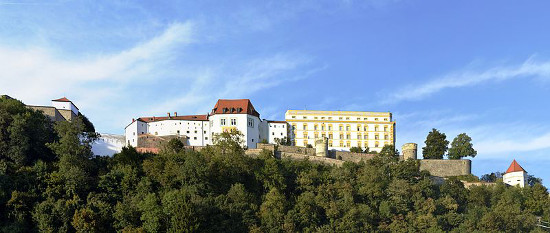What would it have cost to build a tower house around 1400? And what would the same building cost today? That’s what researchers working on an exhibition about castles wanted to find out.
Oberhausmuseum (Passau). Veste Oberhaus (15th century). Photo: Wolfgang Sauber / http://creativecommons.org/licenses/by-sa/3.0/deed.en
The starting point of their calculations was of course the construction time. Two experts independently arrived at the same estimate, which is roughly two years. Based on that, calculations were made and listed in a detailed table.
| Labour costs | ||
| Construction costs around 1400 | Construction costs today | |
| Construction time approx. 250 days | Construction time approx. 200 days | |
| 10 brick layers for 250 days 600 gulden |
6 brick layers for 200 days 325,000 EUR |
|
| 5 carpenters for 200 days 230 gulden |
4 carpenters for 20 days 15,000 EUR |
|
| 15 unskilled workers for 250 days 500 gulden |
3 unskilled workers for 200 days 150,000 EUR |
|
| 1 foreman for 200 days 75,000 EUR |
||
| stone masons 35,000 EUR |
||
| transport 15,000 EUR |
||
| 1.330 gulden | 615,000 EUR | |
| Material costs | ||
| 20 gulden | Sand: 250 Cubic metres | 3,500 EUR |
| 55 gulden | Limestone: 90 Cubic metres | 8,000 EUR |
| 90 gulden | Hewn quarry stones | 150,000 EUR |
| 20 gulden | Moulded bricks | 12,500 EUR |
| 15 gulden | Wooden beams | 10,000 EUR |
| 30 gulden | Other: iron, tools, ropes, baskets … | |
| 230 gulden | 184,000 EUR | |
| Total costs | ||
| Approx. 1,600 gulden | Approx. 850,000 EUR | |
| That equals | ||
| 200 t | Corn | 6,000 t |
| 11,500 pairs | Shoes | 11,500 pairs |
| 7,500 l | Wine | 170,000 l |
| 8,000 | Working days of a brick layer | 3,200 |
| Average income of a town per annum | ||
| 1,500 gulden (Siegen) | 110,250,000 EUR (Passau) | |
| Share of the annual budget of a small town at that time | ||
| about 94 % | 0.8 % | |
While it took 30 men to build a castle during the Middle Ages, today it would take less than half of that. Consequently, the labour costs were considerably higher in the Middle Ages than they would be today. Whereas they amount to 83 % of the overall cost around 1400, today they would only amount to 70 %.
Interesting is also the attempt to convert the financial costs into goods. The equivalent of the tower house, for instance, would have bought you 11,500 pairs of shoes. This is, by the way, exactly the number you could buy for it today.
The relative food prices were considerably higher around 1400: the equivalent of the total cost was only 200 t of corn; nowadays, the price equals roughly 30 times as much corn. Labour force, on the other hand, was cheap, even if less effective as shown in the table above.
The castle’s value was as much as 8,000 day wages of a brick layer. If he had wanted to build a castle for himself, he would have had to work every day for almost 22 years and save every penny to cover the costs; if he wanted to do this today, it would only take him a bit less than 9 years.
Veste Oberhaus, Passau. Photo: High Contrast / http://creativecommons.org/licenses/by/3.0/de/deed.en
Taking the construction costs and converting them into the average annual income of a town around 1400 and today is at least as noteworthy. The annual income of Siegen, which had around 2,000 inhabitants at that time, serves as an example of the Late Middle Ages. With a construction time of two years, the city would have had to spend 50 % of its total budget each year to build the castle. Today, the 50,000 inhabitants of Passau would have to invest only 0.4 % of their budget to raise the tower house. No wonder they are putting up towers of concrete everywhere in our cities, one after another.
The data, like the table, is based on a catalogue issued for the 1998 exhibition „Ritterburg und Fürstenschloß“ (“Knight’s castle and Duke’s palace”) in Passau.
Full bibliographic details: Ritterburg und Fürstenschloß, Begleitband 1 zur Ausstellung von Stadt und Diözese Passau im Oberhausmuseum Passau 1998, ed.: H. W. Wurster und R. Loibl, Passau 1998, p. 54.





